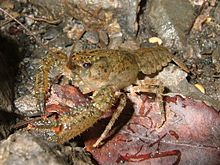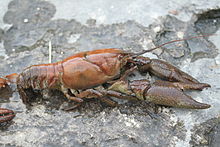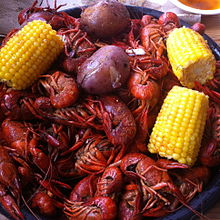 |
Canku Ota
|
 |
|
(Many Paths)
|
||
|
An Online Newsletter
Celebrating Native America
|
||
|
December 2016 - Volume
14 Number 12
|
||
|
|
||
|
Crayfish
|
||
|
by Wikipedia, the free
encyclopedia
|
||
Crayfish, also known as crawfish, crawdads, freshwater lobsters, mountain lobsters, or mudbugs, are freshwater crustaceans resembling small lobsters, to which they are related; taxonomically, they are members of the superfamilies Astacoidea and Parastacoidea. They breathe through feather-like gills. Some species are found in brooks and streams where there is running fresh water, while others thrive in swamps, ditches, and rice paddies. Most crayfish cannot tolerate polluted water, although some species such as Procambarus clarkii are hardier. Crayfish feed on living and dead animals and plants. NamesThe name "crayfish" comes from the Old French word escrevisse (Modern French écrevisse). The word has been modified to "crayfish" by association with "fish" (folk etymology). The largely American variant "crawfish" is similarly derived. Some kinds of crayfish are known locally as lobsters, crawdads, mudbugs, and yabbies. In the Eastern United States, "crayfish" is more common in the north, while "crawdad" is heard more in central and southwestern regions, and "crawfish" further south, although there are considerable overlaps. The study of crayfish is called astacology. Other animals In Singapore, the term crayfish typically refers to Thenus orientalis, a seawater crustacean from the slipper lobster family. True crayfish are not native to Singapore, but are commonly found as pets, or as an invasive species (Cherax quadricarinatus) in the many water catchment areas, and are alternatively known as freshwater lobsters. AnatomyThe body of a decapod crustacean, such as a crab, lobster, or prawn (shrimp), is made up of twenty body segments grouped into two main body parts, the cephalothorax and the abdomen. Each segment may possess one pair of appendages, although in various groups these may be reduced or missing. On average, crayfish grow to 17.5 centimetres (6.9 in) in length, but some grow larger. Walking legs have a small claw at the end. Geographical distribution and classification
There are three families of crayfish, two in the Northern Hemisphere and one in the Southern Hemisphere. The Southern Hemisphere (Gondwana-distributed) family Parastacidae lives in South America, Madagascar and Australasia, and is distinguished by the lack of the first pair of pleopods. Of the other two families, members of the Astacidae live in western Eurasia and western North America and members of the family Cambaridae live in eastern Asia and eastern North America. Madagascar has an endemic genus, Astacoides, containing seven species. Europe is home to seven species of crayfish in the genera Astacus and Austropotamobius. Cambaroides is native to Japan and eastern mainland Asia. North America Crayfish were introduced purposely into a few Arizona reservoirs and other bodies of water decades ago, primarily as a food source for sport fish. They have since dispersed beyond those original sites. Australia New Zealand Fossil records of crayfish older than 30 million years are rare, but fossilised burrows have been found from strata as old as the late Palaeozoic or early Mesozoic. The oldest records of the Parastacidae are in Australia, and are 115 million years old. Crayfish plagueSome crayfish suffer from a disease called crayfish plague, caused by the North American water mould Aphanomyces astaci which was transmitted to Europe when North American species of crayfish were introduced there.[21] Species of the genus Astacus are particularly susceptible to infection, allowing the plague-coevolved signal crayfish to invade parts of Europe. Uses
Food As of 2005, Louisiana supplies 95% of the crayfish harvested in the US. In 1987, Louisiana produced 90% of the crayfish harvested in the world, 70% of which were consumed locally. In 2007, the Louisiana crawfish harvest was about 54,800 tons, almost all of it from aquaculture. About 70%–80% of crayfish produced in Louisiana are Procambarus clarkii (red swamp crawfish), with the remaining 20%–30% being Procambarus zonangulus (white river crawfish). Bait The result of using crayfish as bait has led to various ecological problems at times. According to a report prepared by Illinois State University, on the Fox River and Des Plaines River watershed, "The rusty crayfish (used as bait) has been dumped into the water and its survivors outcompete the native clearwater crayfish". This situation has been repeated elsewhere, as the crayfish bait eliminates native species. The use of crayfish as bait has been cited as one of the ways zebra mussels have spread to different waterways, as members of this invasive species are known to attach themselves to crayfish. Pets
Crayfish are kept as pets in freshwater aquariums. Crayfish kept as pets in the US from local waters are usually kept with bluegill or bass, rather than goldfish or tropical or subtropical fish. They prefer foods like shrimp pellets or various vegetables, but will also eat tropical fish food, regular fish food, algae wafers, and small fish that can be captured with their claws. They will sometimes consume their old exoskeleton after it has moulted. Their disposition towards eating almost anything will also cause them to explore the edibility of aquarium plants in a fish tank. However, most species of dwarf crayfish, such as Cambarellus patzcuarensis, will not destructively dig or eat live aquarium plants. They are also relatively non-aggressive and can be kept safely with dwarf shrimp. Because of their very small size of 1.5 inches (38 mm) or less, some fish are often a threat to the crayfish. Since crayfish are accustomed to being in ponds or rivers, they will have a tendency to shift gravel around on the bottom of the tank, creating mounds or trenches to emulate a burrow. Crayfish will often try to climb out of the tank, especially if an opening exists at the top that they can fit through. In some nations, such as the United Kingdom, United States, Australia, and New Zealand, imported alien crayfish are a danger to local rivers. The three species commonly imported to Europe from the Americas are Orconectes limosus, Pacifastacus leniusculus and Procambarus clarkii. Crayfish may spread into different bodies of water because specimens captured for pets in one river are often released into a different catchment. There is a potential for ecological damage when crayfish are introduced into non-native bodies of water (e.g., crayfish plague in Europe). Invasive speciesCrayfish have been recorded as an invasive species from Louisiana to Europe to China. They have been known to consume local rice crops in China. |
||||||||||||||||||||||||||||||||||||||||||||
|
|
||
|
|
||
| Canku Ota is a free Newsletter celebrating Native America, its traditions and accomplishments . We do not provide subscriber or visitor names to anyone. Some articles presented in Canku Ota may contain copyright material. We have received appropriate permissions for republishing any articles. Material appearing here is distributed without profit or monetary gain to those who have expressed an interest. This is in accordance with Title 17 U.S.C. Section 107. | ||
|
Canku Ota is a copyright ©
2000 - 2016 of Vicki Williams Barry and Paul Barry.
|
||
 |
 |
|
|
The "Canku
Ota - A Newsletter Celebrating Native America" web site and
its design is the
|
||
|
Copyright ©
1999 - 2016 of Paul C. Barry.
|
||
|
All Rights Reserved.
|
||




.jpg)